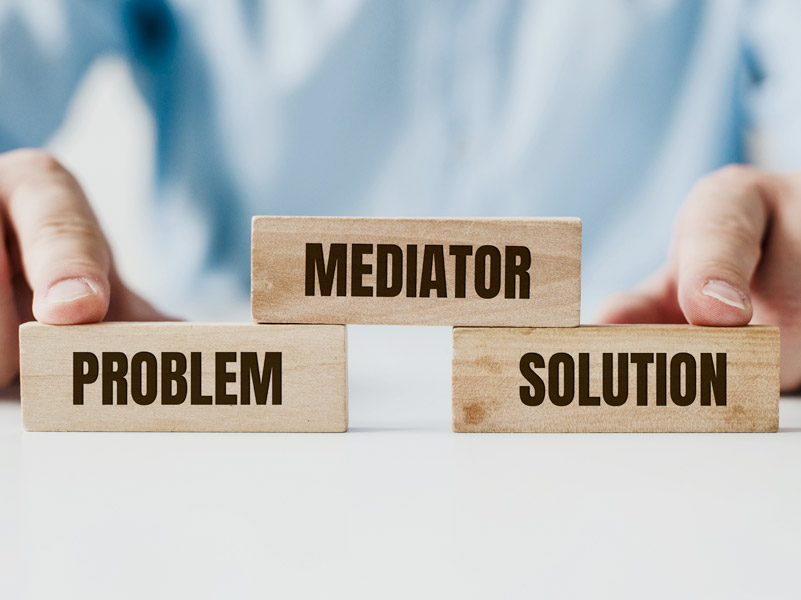Expectations and Negotiation Throughout the Mediation Process

The goal of ADR is to provide a forum for the parties to work toward a voluntary, consensual agreement through negotiation.
Alternative dispute resolution (ADR) refers to any means of settling disputes outside of a courtroom. Such a settlement typically involves the use of services of a neutral party to assist in reaching an agreement and offering a compelling alternative to litigation. Types of ADR include arbitration, mediation, negotiated rulemaking, neutral fact finding, and minitrials. With the exception of binding arbitration, the goal of ADR is to provide a forum for the parties to work toward a voluntary, consensual agreement through negotiation, as opposed to having a judge or other authority decide the case.
Ultimately, meditation is a non-judicial and cost-conscious form of dispute resolution.
Jeff Cohen once said: “Mediation is conflict’s way of looking at itself.” This quote encapsulates the essence of mediation, which not only focuses on conflict resolution, but also ensures a party-centered process. Mediation leaves the decision power wholly within the hands of the parties involved and offers a flexible alternative to arbitration. It is an informal process in which the parties agree to voluntarily work with a trained, neutral mediator who facilitates negotiations between disputing parties, helping them find a mutually acceptable solution. Both parties in a dispute must agree to mediation.
In seeking alternative dispute resolution, it is paramount to understand the difference between a mediator and an attorney, as there is often inquiry about relevance among the two titles. While a mediator’s main role is to encourage open dialogue and assist in migrating towards a mutually beneficial agreement for both parties, an attorney’s role is to actively negotiate on behalf of the interests of their own client. Any party refusing to mediate needs to ensure that their stance for refusal is reasonable, as the courts will consider any refusal to mediate seriously when making orders as to the costs of the subsequent litigation.
80% of couples who choose mediation are not only able to reach a consensus for settlement, but also avoid costly avenues of dispute and protracted litigation.
The average mediation claim lasts just over a day after having been set up in only a matter of days. From a domestic dispute standpoint, recent studies have approximated that 80% of couples who choose mediation are not only able to reach a consensus for settlement, but also avoid costly avenues of dispute and protracted litigation. These numbers underscore the effectiveness of mediation as a means to resolve disputes and move forward with their lives in a more harmonious manner. But in spite of that, like with most things in life, there is some give and take. In order for mediation to be effective, all parties must be willing to cooperate and appropriately disclose any necessary or relevant information pertaining to the dispute. Otherwise, mediation attempts will be futile, making the entirety of the process unproductive. Consequently, parties also reserve the right to withdraw from mediation.
Commonly, mediation is referred to as having failed when a settlement is not reached, which is not entirely the instance. However, if the parties leave a mediation in a far worse position than when they arrived, that is absolutely a case of fruitless attempt. In addition, it is important to emphasize that it is not in the hands or discretion of the mediator to neither support nor contradict one side of the dispute. Rather, the mediator serves as a vehicle for facilitating amicable settlement. Consequently, mediators understand these processes from all sides of the table, and assist through discussion and guidance without rendering binding decisions.
You can expect your mediation process to follow these relative steps:
-
Preliminary: deciding whether or not to mediate; factors include timing, the need for informal versus formal information gathering, the emotional or business needs of the client relative to resolution, how to suggest mediation to other parties, the mediator best suited for the task and the time to be set to do it right. When early negotiation does not result in a settlement, it often sets the stage for the parties to agree to informal information exchanges and a return to the table.
-
Preparation: preparation for mediation to identify the interests of both parties; a specific need that must be satisfied. When preparing for a mediation, make a list of your client’s interests and set out action items that you can negotiate to meet those interests. Next identify the interests of the opposing party – set out actions to meet those interests. It’s important to identify a competitive or cooperative approach. Do not leave anything out – the more information provided on broad topics the better.
-
Information: With the first two stages completed, the information stage represents the initial contact with the other side at the negotiation. This might be a joint session, or it might even be as simple as a quick hello in the hallway. Here, the introductions are made and the actual dance between the parties is about to begin.
-
Negotiation: Three basic approaches:
-
The competitive bargainer or “hard bargainer” or “positional bargainer.” This negotiator wants to win at all costs, arguing over positions endangers relationships and increases costs in litigation and often produces inferior results.
-
Next is the cooperative negotiator, sometimes thought of as “soft” and wants to get along with everyone and produce an easy outcome in what is often a difficult situation.
-
Then there is interest-based negotiation. In this process there are four key points:
-
Separate the people from the problem.
-
Focus on interests and not positions.
-
Create a variety of possibilities before negotiation or deciding what to do.
-
Focus on objective standards. The back-and-forth of distributive negotiation is hard on the parties. Emotional experiences tend to feel as impersonal as negotiating for a commodity. In a facilitative negotiation, the mediator does not deliver offers as much as concepts, wrapping into the discussion an interest-based analysis through the use of open-ended questions. In this way, the parties themselves can come to their conclusions in an objective manner. It’s not who is right or wrong, it’s what the jury says, and how the process impacts one’s life or business. This is well used in emotional cases. It is driven by issues, and can be much easier and softer on the parties.
-
-
-
Closing: Not until the closing stage is complete and the essential terms of the deal are reduced to a writing and signed by all parties or, if all parties are not present, all participants. This reduces confusion at best and might lead to an enforceable agreement depending on the rules of the jurisdiction. Even if not strictly enforceable, it is best to put pen to paper and draft a memorandum of understanding.
Any dispute, in some aspect, can be messy, time-consuming and stress-inducing. Allowing a neutral to mediate your dispute is a route that will not only save time and money, but also spare you the distress that comes with litigation and other judicial proceedings. Our neutrals are prepared to handle any problem you throw their way and assist in reaching an amicable and mutually-beneficial-consensus. Need a neutral to handle your dispute? Contact us today.












